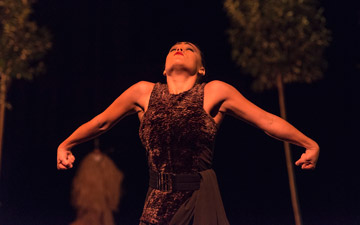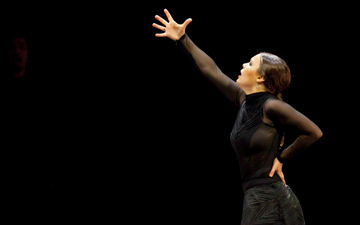
© Foteini Christofilopoulou. (Click image for larger version)
Rocio Molina
Bosque Ardora
London, Barbican
16 October 2014
Gallery of pictures by Foteini Christofilopoulou
www.rociomolina.net
www.barbican.org.uk
What a strange world flamenco dancer Rocío Molina conjures up for us in her latest show, Bosque Ardora. The prodigiously talented Malaga native, who formed her own company at 19 and was awarded the Spanish National Prize for Dance aged just 26, has had even the likes of Mikhail Baryshnikov kneel in admiration before her. With maestros including the great Maria Pagés, and a fierce awareness of flamenco’s history, Molina nevertheless chooses not to stick with traditional formats and has forged an avant-garde path that leads her into all manner of startling creations.

© Foteini Christofilopoulou. (Click image for larger version
Bosque Ardora, part of this year’s Dance Umbrella festival and Molina’s biggest UK show to date, roughly translates as ‘burning wood’ and is imagined on a grand theatrical scale. An opening film sequence, projected on to a massive screen, sees Molina the huntress galloping through woods with her hounds, before being thrown from her horse into a lake and appearing to kneel in its waters.
Her smouldering, combative gaze to camera gives way to Molina in person, on a set ringed with potted trees (some suspended upside-down): a tiny figure, but one with enough presence to fill the Barbican’s main stage. She transforms from huntress to hunted with a rather evil-looking fox mask, and her movements are at once animalistic and highly stylised, seemingly bearing little relation to flamenco as we know it. A flash of showmanship, when her feet striking the ground create actual sparks, is the first real sign of the dance form’s recognisable footwork: by this time she’s been joined by two male dancers and a collection of musicians including a drummer and two trombonists, who make creepy sounds by just breathing through their instruments.

© Foteini Christofilopoulou. (Click image for larger version)
She, Eduardo Guerrero and Fernando Jimenez perform isolated leg movements and make tight turns as another performer provides an eerie soundscape by doing flamenco footwork on a large electronic echo pad. She’s a huntress again, imperious as Artemis, abstracting flamenco into an alien form, sometimes robotic, sometimes languorous when her horn section drifts into blues, sometimes resembling a Hindu apsara from an Angkor Wat carving, or a Japanese Butoh performer. A sense of ritual predominates.
Then, just when you think you’ve got the hang of this hunter goddess/mythological fox duality thing, Molina shrugs off her dress, dons oversized shirt, tie and Pina Bausch-style stilettos and starts doing something that alarmingly resembles twerking. There’s a back and forth between her and her now bare-chested and velvet-skirted male dancers, where she’s first aggressive vamp then subjugated victim. She pulls off some startling flamenco bursts in her high heels, then totters about the stage, collapsing to the floor. The dominatrix/dominated theme lingers on past another costume change. And just when you think it can’t get any weirder, Molina pulls off a climactic sequence involving a terrifying, pagan-looking straw costume and a shotgun.

© Foteini Christofilopoulou. (Click image for larger version)
The programme notes suggest the theme of Bosque Ardora is ‘the fight of nature against culture, in which the most irrational urges override human reason’. I’m not sure I even understand this as a premise. What is clear is that Molina’s ambitious exploration of our most raw instincts is rather overstuffed, and sometimes the self-indulgence takes its toll. Molina’s rigorous precision as a dancer is captivating and the sustained moments of more classical flamenco have a passionate intensity. She is a joy to watch as she pushes her dance form into ever more challenging spheres. As a choreographer, though, in this case she has fallen prey to too great a whirl of artistic impetuses, and the piece feels disjointed and for some stretches utterly baffling.

















You must be logged in to post a comment.